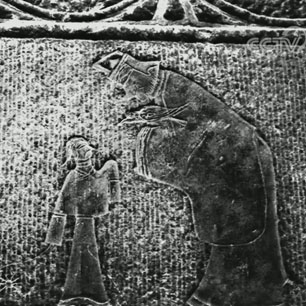
Confucius is the most common historical figure in the art of the Han dynasty, which is seen not only in his hometown in today's Shandong province, but also in the tomb of Haihunhou of the Western Han dynasty (206BC-24AD) in today's Nanchang, Jiangxi province, the murals of the tomb in today's Inner Mongolia autonomous region, and the pictorial stones in today's northern Shaanxi province, manifesting the characteristics of society and ideology at that time.
In the Han Dynasty, the image of Confucius appeared more frequently on coffins, ancestral halls, palaces, tombs, and tomb murals. Same as in the Haihunhou tomb, the Confucius on these burial sites or buildings was portrayed sideways, with his body slightly bowing forward. The difference lies in the combination of characters and the way they were made. Although still portrayed sideways, no statues or murals in the Han Dynasty depicted Confucius facing his disciples. In most images, Confucius faced Lao Tzu or Xiang Tuo, with his disciples standing behind him. These portraits were named "A Portrait of Confucius Seeing Lao Tzu" and "A Portrait of Confucius Seeking Advice", which may be influenced by Sima Qian's narrative.
1. Images of Confucius and his disciples
The earliest known image of Confucius was found in the tomb of Liu He, Marquis of Haihun of the Western Han dynasty (202 B.C.-A.D. 8), in Nanchang, Jiangxi province. On the outside frame of the rectangular mirror buried in the tomb, there are images of Confucius and his disciples and biographies beside them. In the portrait, Confucius and his favorite disciple Yan Hui are on the top, bowing to each other; the disciples are merely outlined, while Confucius is carefully depicted in colored clothes. Confucius, 28.8 centimeters tall and 8.4 centimeters wide in the portrait, has a long beard and a tall and thin figure, and wears a small hat, a long robe, and a pair of formal shoes, with a belt around his waist.
2. Confucius visiting Laozi
The portrait of Confucius visiting Laozi is the most common type of portraits about stories of historical figures on stone carvings and murals of the Han dynasty (202 B.C.-A.D. 220). Its sheer number and the great influence of Confucius and Laozi have attracted much attention of scholars. They have studied and written papers on it, and Xing Yitian, a scholar from China's Taiwan, has published a book exploring Han dynasty portraits of Confucius visiting Laozi.
3. Confucius and Xiang Tuo
As recorded by one of the Chinese classics “Three Character Classic,” Confucius acknowledged child prodigy Xiang Tuo as his master. Many stories and idioms originate from here. Later generations revere Confucius as sage, and thus address Xiangtuo as Shenggong (literally means "senior sage"), and have named a mountain Mount Shenggong.